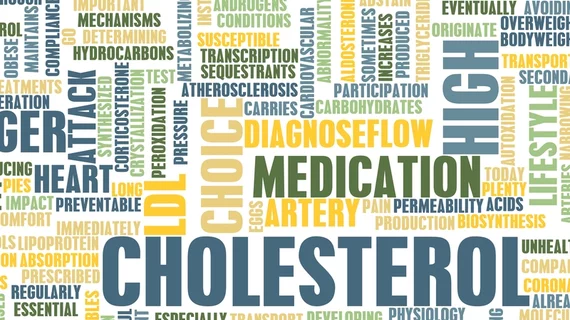Lowering LDL cholesterol (LDL-C) beyond guideline-recommended levels further reduces cardiovascular events without compromising safety, according to a meta-analysis published Aug. 1 in JAMA Cardiology.
Perhaps more surprising, patients starting with much lower baseline levels of LDL-C experienced a near equivalent relative reduction of vascular events—a composite of coronary heart disease death, myocardial infarction, stroke or coronary revascularization—when compared to patients with higher starting cholesterol.
“There is a consistent relative risk reduction in major vascular events per change in LDL-C in patient populations starting as low as a median of 1.6 mmol/L (63 mg/dL) and achieving levels as low as a median of 0.5 mmol/L (21 mg/dL), with no observed offsetting adverse effects,” wrote Marc S. Sabatine, MD, MPH, and colleagues, all with Harvard Medical School. “These data suggest further lowering of LDL-C beyond the lowest current targets would further reduce cardiovascular risk.”
The authors noted that in a meta-analysis of 26 statin trials, patients starting with LDL-C of approximately 131.5 mg/dL experienced a 22 percent reduction in major vascular events for every 38.7 mg/dL drop in LDL-C.
But in a subgroup of patients from that meta-analysis who started with much lower levels (65.7 mg/dL), the relative risk reduction associated with that same drop in LDL-C remained at 22 percent. And in another meta-analysis of three trials of nonstatin therapy in addition to statins, an equivalent lipid-lowering was associated with a 21 percent reduction in adverse events—even though those patients also started out with LDL-C below 70 mg/dL.
“The clinical benefit per millimoles per liter reduction in LDL-C was virtually identical for statins, ezetimibe, PCSK9 inhibition, and CETP (cholesteryl ester transfer protein) inhibition, despite these drugs having different effects on other risk markers such as high-density lipoprotein cholesterol, lipoprotein(a), and high-sensitivity C-reactive protein,” Sabatine et al. wrote. “This observation reinforces the notion that the reduction in LDL-C (or more broadly, atherogenic apolipoprotein B–containing particles) is the primary driver of clinical benefit.”
Even though the risk reduction with each incremental drop is equivalent across the LDL-C spectrum, the greatest absolute risk reductions will be present in those with higher baseline cholesterol. In other words, they are at a higher risk level to begin with so the same relative reduction in adverse events would result in the avoidance of a greater number of events.
But, the authors noted, “because there were no offsetting safety concerns with LDL-C lowering through this range, the benefit-risk ratio from a medical perspective should always remain favorable.”
Cost-effectiveness analyses may be a different story, though, particularly for PCSK9 inhibitors, which don’t currently have a cheap, generic option available.
In a related editorial, Antonio M. Gotto, MD, DPhil, pointed out there are no safety concerns yet for dropping LDL-C below a certain threshold, but it’s too early to definitively make that conclusion. At some point, a floor will be reached, he predicted.
“The level of LDL-C in newborn humans has been reported at 22 to 45 mg/dL. Detecting adverse events when the LDL-C is reduced to levels less than those present at birth may require longer periods of follow-up than were included in the FOURIER and ODYSSEY Outcomes trials,” wrote Gotto, with Weill Cornell Medicine in New York.
“While it is possible to calculate how low LDL-C levels can be reduced while still detecting a cardiovascular benefit, one reaches a point of diminishing returns, and it is not clear how low it is safe to go.”

